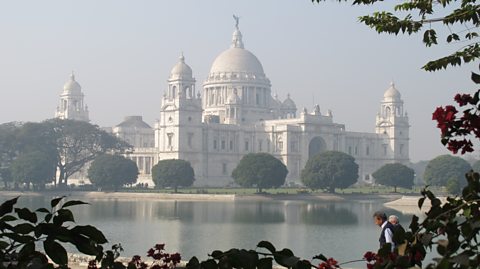DAN SNOW: Just over four hundred years ago a group of London merchants arrived here on the Indian coast hoping to do some peaceful trading. Those early pioneers dreamt of making huge profits.
Over two hundred years, the company they formed grew into a commercial titan.
Its wealth rivalled that of the British state.
It had its own army, and eventually ruled over four hundred million people.
Its trade was vital to Britain's commercial success, and it revolutionised the British lifestyle.
Speaker 2: The East India Company changed the way we dress, er, it changed the way we eat, it changed the way we socialise.
DAN SNOW: And by accident, created one of the most powerful empires in history.
But the company's rise was followed by a dramatic descent into profiteering and corruption…
and eventually a chilling story of unchecked greed with devastating consequences.
The East India Company and its early trading activities had a huge influence on the British way of life, both in India and back in Britain.
People were eager to learn about this exotic place with its very different customs, dress and culture, and the Indian products that the company exported to Britain became more popular than their British equivalents.
By 1700, goods were flooding across the sea from India.
[to Tea seller] Can I have a single tea, please?
It was the beginning of new kinds of diets, of choice, of consumerism.
People could now choose to have sugar from the West Indies, pepper from India. It was also the start of the Brits obsession with hot drinks. Tea and coffee arrived for the first time.
[to Tea seller] Thanks very much. Delicious.
Gingham, silk, muslin, calico. Back in Britain, the company was importing a cavalcade of rich new fabrics. Bowled over by the exquisite skill of India's craftsmen, the British public went crazy.
Eighteenth-century Indian textiles held at London's Victoria and Albert Museum revealed an impressive range of techniques were used in their manufacture.
Speaker 3: All these objects are made of chintz, which is basically cotton, which has been hand painted rather than printed.
The Indians managed to find ways of dyeing cotton so the colours remained brilliant and were colour-fast. So, that was very exciting for people in the West.
DAN SNOW: Cheap, washable and hard-wearing, they made a huge impact.
Speaker 3: Less formal clothing became acceptable and fashionable, and it certainly worried the British textile industry, as they were very fearful that there would be no demand for their own wool and linen products.
And at one point it caused such a sensation and so much fear amongst the silk workers that they tore the clothes off people's backs.
DAN SNOW: Really?
Speaker 3: Because they thought their livelihoods were threatened.
So it was that dramatic.
DAN SNOW: Company merchants were quick to respond to the consumers' changing tastes.
Speaker 3: The East India Company would report back regularly after every shipment to Britain from India, saying, "Well, we like this but these didn't sell so well.
"And could you do more of the floral sprigs? "Or could you do more of this colour?"
DAN SNOW: The British retail fashion industry was born.
Pyjamas, bandanas, dungarees.
Dozens of new words entered the English dictionary. Demand for Indian textiles was so great it threatened to destroy Britain's industry.
Speaker 4: "Everything that used to be made of wool or silk "relating to either the dress of women or the furniture of our houses "was supplied by the India trade."
DAN SNOW: The government even passed a law to ban people from wearing Indian textiles, but it didn't work, testimony to the rising power of the consumer.
Over the next hundred years, sales of Indian textiles would generate sixty percent of the company's income. While the British back at home were succumbing to Indian influences, the British in India were also changing.
Many Company men formed lifelong relationships with Indian women, and some even adopted the local tradition of polygamy.
The East India Company had serious misgivings about its employees cohabiting with local women.
But then again, knowledge of local markets was good for business.
Speaker 2: Liaison with indigenous women teach men languages, so the company really has a vested interest in these relationships being close and tight-knit.
DAN SNOW: By the middle of the eighteenth century, ninety percent of Company employees in India had local partners.
[FOREIGN LANGUAGE]
Many could now afford several mistresses, and a house full of servants.
[to driver] Right, let's go.
But something odd was going on. They'd arrived here as humble merchants, but their new-found wealth was having a bizarre effect.
They adopted the ostentatious, flamboyant lifestyles of an Eastern prince, surrounding themselves with armies of servants, being carried from place to place in a palanquin.
The pomposity and extravagance of these white Mughals knew no bounds.
Much to the annoyance of their fellow countrymen.
Speaker 4: "Many of the British inhabitants affect great splendour "in their mode of living. They assume an air of much consequence "and often treat the rest of their countrymen "with supercilious arrogance."
DAN SNOW: I think this is my favourite picture from the period.
It shows a man who looks like a Mughal emperor. He's sitting on a cushion, smoking a hookah, attended by servants, master of all he surveys in his luscious robes and turban. But that is no Mughal emperor.
In fact, it's an accountant from Yorkshire. His name's John Woonwell. He's living the dream.
While some lived like overblown maharajas, others, like Major-General Charles Stuart, engaged with India on a more profound level.
Charles Stuart came out here from his native Ireland aged nineteen and immediately fell in love with the place. He had a house here on Wood Street, which he turned into a museum, filling it up with Indian artefacts and carvings.
He was happy to show anybody around and share his passion for all things Indian.
Stuart's encounter with India changed his life. Within a year of his arrival he had discarded Christianity and become a Hindu.
"Hindoo Stuart", as he became known, learned the local languages, dressed like a local, would have been very comfortable in places like this. He took a local woman as a wife and had a brood of mixed-race children.
He even hired a group of Brahmins, Hindu scholars, to prepare the family's food in traditional Hindu manner.
Stuart wasn't unusual in embracing his new home.
Many Britons and Indians accepted each other in an atmosphere of mutual understanding.
Speaker 3: The British came to India before the nineteenth century very much as explorers, adventurers and people out to make their money. And they encountered a very old and very complex civilisation.
And they were often impressed by it. And so they didn't feel that they were in any way superior to Indians, they were just simply one of a number of groups jostling in India to try and earn a living and to try and make their way.
DAN SNOW: In these early days of the Company's activities in India, respect and tolerance for Indian customs, culture and religion were encouraged.
They weren't there to change India or Indians but to profit from them.
In the final analysis, integration was good for business,
and business was what mattered to the Company above all else.
Video summary
Dan Snow describes how the British embraced Indian customs in the 18th century both through changes in fashions and culture.
Some members of the Company were eager to learn about this new exotic place with its different customs, dress and culture.
Dan discusses Major General Charles Stuart and his adoption of Hindu practices, Indian languages and dress.
He talks about 18th century culture, orientalism, curiosity about India and an enlightenment mentality that was common during theperiod, as well as other cultural influences on British life, including hygiene.
Teacher Notes
Pupils could be asked to identify the different types of influences which the growth of the East India Company had.
They could focus on three areas: tastes and fashions in England, lifestyle of East India Company merchants, and the reaction of the Company to these influences.
This short film will be relevant for teaching KS3 history in England, Wales and Northern Ireland and Third / Fourth level in Scotland.
History KS3: Conflict and Mutiny. video
The position of the Company comes under threat from forces at home and in India, resulting in India eventually being given to Queen Victoria.

History KS3: From Greed to Famine. video
The riches accrued from the Company’s success gave men such as Clive enormous influence in Parliament and society. However, events in India meant that it wouldn’t last.

History KS3: From Merchants to Rulers. video
After the crash, the British government took over the Company, expanded its territories and built an empire.

History KS3: The Rise of a Trading Colossus. video
A short film which describes the development of the East India Company, which grew from a trading enterprise to possess the powers of a small state.

History KS3: The Seven Years War. video
A short film explaining how the East India Company overcame opposition from the French to gain control of India.

Ěý